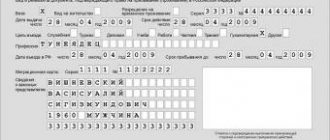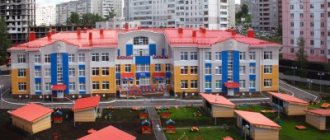Business lawyer > Opening a business > How to set up a stall in the city: choosing a location, registration, amount of investment
For a novice entrepreneur without experience and a large amount of funds, opening a stall may be a good option. Managing such a business is not difficult, so you can keep your job. Although the level of competition in trade is not encouraging, a mini-store can be the beginning of a larger business if you take advantage of the advantages: the ability to determine working hours convenient for customers and an individual approach. The likelihood of success increases if a unique product is selected.
Make a sign
We are used to the fact that a trade sign
looks like a colorful banner with the name of the store. But from a legal point of view, this is a sign on which the seller is obliged to place basic information about the store:
- company name;
- legal address;
- operating mode.
If you want to tell them that you accept card payments, you can, for example, put a sticker from the bank on the door. But the information on the sign should not mislead buyers. In particular, do not write your actual address instead of your legal address.
Before ordering a sign, talk to your landlord; they may want the sign to match the overall style of the building. Some shopping centers even have rules for placing signs - read them so you don't have to redo them later.
—
For working without a trade sign and providing incorrect data, you will have to pay a fine: up to 2.5 thousand rubles for individual entrepreneurs or up to 40 thousand rubles for legal entities.
Design a consumer corner
The consumer corner is a list of documents placed on a special stand inside the store. This is what should be there:
- certificates of OGRN/OGRNIP, TIN and name of the registering authority;
- licenses, accreditation certificates, work certificates;
- telephone number of the contact person to whom the client can complain (for example, a director or manager);
- contacts of the territorial body of Rospotrebnadzor, police and fire services;
- Law on Consumer Protection";
- rules of trade and provision of services;
- book of complaints and suggestions;
- audit log.
Any store visitor should have free access to the consumer corner. Read more about how to design a consumer corner
, we wrote in this manual.
—
Fines for violations are the same as in the absence of a trade sign: up to 2.5 thousand for individual entrepreneurs or up to 40 thousand rubles for legal entities.
Starting a business
To open your own trade kiosk, you need to prepare the necessary documents, choose a location, and purchase equipment. When starting, it is recommended to follow some rules:
- you need to register as an individual entrepreneur;
- there must be documents confirming permission to place a stall in a certain location;
- you need to purchase a trade pavilion or kiosk;
- you need to purchase equipment for the stall: racks, shelves and refrigerators;
- it is necessary to hire salespeople to work at the kiosk.
Before opening your own trading kiosk, you must register with the relevant authorities as an individual entrepreneur. This is done so that you can use a simplified taxation system.
After receiving a certificate of registration of an individual entrepreneur, you need to contact local authorities and obtain permission to install a retail outlet.
A similar permit is required from the city's architectural department. You will have to obtain papers from Rosstat and the Pension Fund. You can prepare all the documents yourself or entrust this matter to people who know all the loopholes and will help you complete the documentation faster. While preparing documents, you can simultaneously search for a place to install a retail outlet.
Place the right price tags
To register a point of sale
, make price tags for each product category. They must be the same shape, size, color and contain the following information:
- Name of category, manufacturer.
- Date of production and placement on display.
- Quantity of goods (for example, in packaging).
- Basic characteristics (for example, size, model, composition).
- The final price per unit of goods in rubles (liter, kilogram, piece).
If you are organizing a promotion, make price tags of a different color and write on them the conditions under which the discount applies. For example, the standard price is 100 rubles, but with a loyalty card it is reduced by 20%, to 80 rubles.
The role of the price tag is performed by paper stickers, an electronic or illuminated display, a slate board or a stand. You can only choose one of the options; you cannot combine them. For example, if you want to turn paper price tags into electronic ones, be prepared to change them under each product category.
—
If they are not there or you invite the buyer to find out the cost at the checkout when purchasing, he has the right to complain to Rospotrebnadzor. The store will be fined 10 thousand rubles. And if the information about the product on the price tag is incorrect, the fine can rise to 500 thousand rubles.
The price tag is considered a public offer. This means that the buyer has the right to purchase the goods at the specified price, even if in reality it is higher, and the seller forgot or did not have time to provide the correct information.
List of kiosk equipment
The most important thing is the structure. If it is rented, all that remains is to furnish it from the inside. When renting a plot of land, you will have to choose one of three options:
- hire carpenters for construction
- buy a ready-made “box”
- buy a mobile structure
The ideal option for a novice businessman is to rent from the municipality. The initial investment will be minimal, since most of these structures already have utilities.
Buying a ready-made pavilion is faster and easier. It will be delivered and installed in one day, all that remains is to connect the utilities. You can find a supplier who will make a burglary-resistant door, security roller shutters, and a reinforced floor for a street kiosk. Some manufacturers of similar structures offer blinds, shelving, air conditioners and other useful equipment.
The arrangement of the premises depends on the type of product. If food is sold, a refrigerator is needed. In any case, sellers cannot do without shelving, display cases, scales, a cash register, a table and a chair. If there is no heating system, you will have to use an electric heater in winter. In a highly competitive environment, a bright sign is desirable.
Decorate your window display for the holidays
In some regions, stores are required to decorate their windows for the holidays. If local authorities have adopted a law on the design of retail outlets, you will have to “dress up” the shelves, the facade and put themed products on the shelves.
For example, in Moscow, entrepreneurs were required to decorate windows for holidays and memorable days. They check the readiness of stores in advance - 10 days before the holiday. The exception is New Year: you need to decorate the window before December 1st.
—
If you forget about the festive decorations, there will be a fine: from 10 to 50 thousand rubles for companies and individual entrepreneurs, from 10 to 20 thousand for managers.
Russian Railways terminated lease agreements with owners of stalls at Moscow stations
Why are stalls being removed from train stations?
Plutnik, in his instructions, refers to a memo to the head of Russian Railways, Oleg Belozerov, on November 27 (he left his resolution on the document). According to the document (a copy of it was also published by Vgudok, the essence was confirmed by a representative of Russian Railways) at eight Moscow stations - Leningradsky, Yaroslavsky, Kazansky, Paveletsky, Belorussky, Kievsky, Rizhsky and Savelovsky - and station areas, as well as 50 platforms in the Moscow region, 264 non-stationary trade objects are located . The note does not indicate only the Kursk station, but it is mentioned in Plutnik’s instructions. “The type and format of these objects are not systematized, there are no uniform requirements for their placement,” the deputy head of Russian Railways points out in the letter.
The head of Russian Railways recalled plans to speed up travel from Moscow to St. Petersburg Society
Read on RBC Pro
What tax innovations have the authorities prepared for src=»https://s0.rbk.ru/v6_top_pics/media/img/5/36/756337447457365.jpg» class=»aligncenter» width=»1536″ height=»960″[/ img]Swimming shallow: how does the thinking of a leader differ from the thinking of a performer
The Russian insurer is going for an IPO with a valuation of up to $1 billion. What is important to know
“Commodity prices could collapse”: Cathie Wood on risks in stock markets
Plutnik explains the termination of lease agreements and dismantling by the need to “improve the quality of passenger service and create a modern architectural appearance of railway infrastructure facilities.” “Until Russian Railways approves uniform requirements for registration of non-stationary trade facilities, their placement will not be carried out,” he added. “The adoption of new standards and the renewal of lease agreements will happen quite quickly. Everyone - both Moscow and Russian Railways - is interested in restoring service as quickly as possible,” clarifies a source close to Russian Railways.
“The architectural appearance of trade and service facilities is currently being developed; it will be agreed upon with the relevant executive authorities of the city of Moscow and the Moscow region in the first quarter of 2021. These properties will be offered to tenants in a new format,” a Russian Railways representative confirmed to RBC.
The press service of the Moscow Department of Transport told RBC that together with Russian Railways they are carrying out “systematic work” to improve the quality of passenger service on railway transport. This also applies to retail facilities, their appearance, location, and range of goods.
Previously, Russian Railways had a plan to transform some stations into modern shopping clusters following the example of European stations, which was never implemented then, recalls the founder of the Teremok chain, Mikhail Goncharov. In August 2021, at a meeting of the Russian Railways Investment Committee, the modernization of four Moscow stations - Kievsky, Belorussky, Kursky and Savelovsky - was discussed in order to increase capacity, improve passenger comfort, and increase tax revenues from the implementation of business projects. The modernization was to be carried out by the subsidiary of Russian Railways, RZD-Real Estate. RBC sent a request to the press service of Russian Railways about the further development of this project.
How Russian Railways increased the profitability of stations
Russian Railways has been dealing with the issue of profitability of station premises since 2008: then the concept of the effective use and development of railway stations until 2015 was approved (later updated until 2030). The concept involved the modernization of Russian train stations, during which all spontaneous trade around the stations was dispersed. The company began searching for new tenants: coffee shops, pharmacies, bookstores, and also planned that dry cleaners, bank branches, and boutiques would appear at the stations.
In 2008, Russian Railways decided for the first time to attract a private investor to manage the station - it became Sergei Polonsky's Mirax Group. In a pilot project at the Kursk station, together with Russian Railways, the operator chose tenants of the station's retail premises - they were the Arkady Novikov group of companies, Coffee House, Rosinter, the Rigla and Stary Lekar pharmacy chains, as well as Euroset and the network perfume stores "L'Etoile". The Novikov Group even planned, together with Russian Railways, to develop food standards at Russian stations, select food operators and control the quality of food. However, the contract for managing the station with the Mirax Group structure was terminated at the end of 2009, and Novikov himself subsequently told Kommersant that his group’s cooperation with Russian Railways is “sluggish: the monopoly cannot provide sites for restaurants, since they are already rented by someone "
In 2013, a subsidiary of Russian Railways, Catering at Stations, independently identified catering operators for Moscow stations. They were Rosinter Restaurants Holding (Il Patio, Planet Sushi chains), franchisees of KFC and Subway, G.M.R. Planet of Hospitality" (previously owned the Sbarro franchise). Then 10 thousand square meters were allocated for restaurants and food courts at Moscow train stations. m.
How many stalls are being dismantled?
The termination will affect only lease agreements for the placement of non-stationary trade facilities; at Moscow stations there are 148 out of 1332 of all lease agreements, in the Moscow region - 64 out of 652, a representative of Russian Railways indicates. Plutnik’s letter sent to Belozerov stated that the annual rent under 148 contracts in Moscow (concerning the placement of 176 non-stationary trade facilities) is 427.72 million rubles. excluding VAT, and under 64 contracts in the Moscow region (88 trade objects) - another 17.4 million rubles. in year.
Almost 150 people without masks were fined at Moscow train stations per day Society
“The termination of lease relations for the placement of non-stationary retail facilities will be carried out in strict accordance with the requirements of the legislation of the Russian Federation and the terms of the relevant agreements, which provide for the right of Russian Railways to terminate the agreement unilaterally, subject to notification to the tenant one month before the date of termination of the agreement,” notes a company representative. In accordance with the provisions of the Civil Code (Article 310), unilateral refusal to fulfill contractual obligations is not allowed by default, but the law provides for the possibility of including in the contract conditions that allow it to be terminated at the initiative of one of the parties by sending appropriate notice, says the managing partner of the Bishenov bureau and partners" Alim Bishenov.
“The Department of Transport supports the development of small and medium-sized businesses. At the same time, the placement of any retail facilities should not create inconvenience and should not steal space from passengers. The appearance of retail outlets should not interfere with the comfort and safety of travel,” says a representative of the Moscow Department of Transport. “Russian Railways will independently develop new trading standards at Moscow stations, but at the same time, the position of the Moscow authorities will have weight,” added a source close to Russian Railways.
Owners of non-stationary trade facilities located on the territory of Russian Railways already know about the upcoming decision, noted Vladlen Maksimov, president of the Association of Small-Format Trade. “Probably, previously some of the space was leased to not very transparent companies, and now Russian Railways wants to introduce uniform rules. We are not talking about everyone being kicked out; on the contrary, there are more retail spaces, they will be actively developed,” he explained. In his opinion, there is no need to introduce strict uniform requirements for the design of retail outlets; they should simply be “reasonably integrated into the overall space, like in a shopping center.” Now, according to the Association of Small-Format Trade, Russian Railways has a rental price for space for a large retail facility of 24 square meters. m is 360 thousand rubles. per month.
The Cofix coffee chain (there are six points at Moscow stations, two of which may fall under the category of non-stationary retail outlets) supports Russian Railways’ desire to improve the station areas, says Cofix real estate director Elena Karamysheva. “But at the same time, we are aware that in these difficult times, additional costs associated with business relocation will place a particularly heavy burden on the shoulders of entrepreneurs and representatives of small and medium-sized businesses,” she added. In her opinion, Russian Railways should postpone this initiative to a more favorable time.
Goncharov noted that one of the cafes of the Teremok chain is at the Kursky railway station, the point is subleased and the tenant is aware of the plans of Russian Railways. “Teremok” is ready to participate in the project of an updated holistic trading concept for stations, he added.
How Moscow demolished stalls
In February 2021, a large-scale reform of non-stationary trade in Moscow affected stalls near metro stations. They were not saved even by the fact that the ownership of most of the stalls was registered in the State Register for private individuals. “The demolition of illegal buildings in Moscow is a clear example of the fact that in Russia the truth, heritage, and history of our country are not for sale. You cannot hide behind pieces of property that were clearly acquired through fraudulent means. Let’s return Moscow to Muscovites,” Moscow Mayor Sergei Sobyanin said at the time.
If before the reform, entrepreneurs rented land from the city and could build various structures on it, now the city itself builds pavilions. All of them, with the exception of underground ones, have a clear specialization and are made in the same style.











